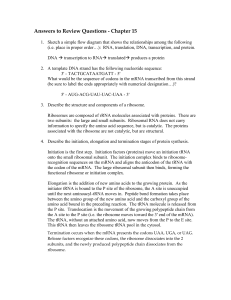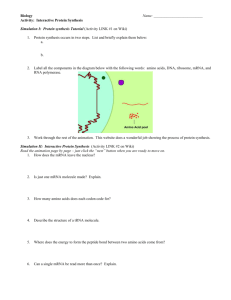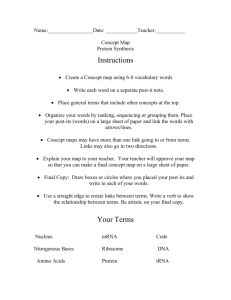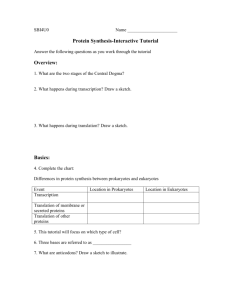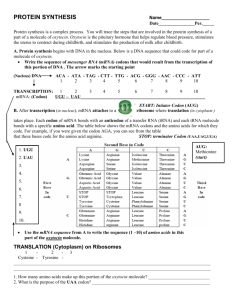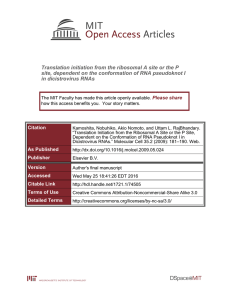Biology 212 General Genetics
advertisement
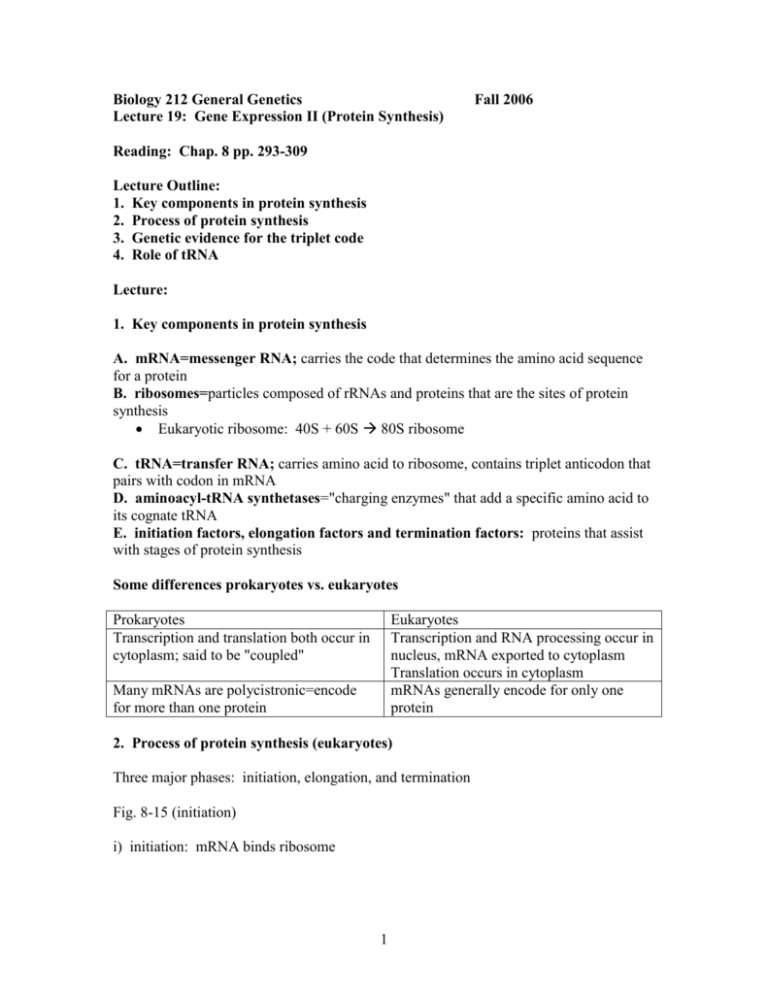
Biology 212 General Genetics Lecture 19: Gene Expression II (Protein Synthesis) Fall 2006 Reading: Chap. 8 pp. 293-309 Lecture Outline: 1. Key components in protein synthesis 2. Process of protein synthesis 3. Genetic evidence for the triplet code 4. Role of tRNA Lecture: 1. Key components in protein synthesis A. mRNA=messenger RNA; carries the code that determines the amino acid sequence for a protein B. ribosomes=particles composed of rRNAs and proteins that are the sites of protein synthesis Eukaryotic ribosome: 40S + 60S 80S ribosome C. tRNA=transfer RNA; carries amino acid to ribosome, contains triplet anticodon that pairs with codon in mRNA D. aminoacyl-tRNA synthetases="charging enzymes" that add a specific amino acid to its cognate tRNA E. initiation factors, elongation factors and termination factors: proteins that assist with stages of protein synthesis Some differences prokaryotes vs. eukaryotes Prokaryotes Transcription and translation both occur in cytoplasm; said to be "coupled" Eukaryotes Transcription and RNA processing occur in nucleus, mRNA exported to cytoplasm Translation occurs in cytoplasm mRNAs generally encode for only one protein Many mRNAs are polycistronic=encode for more than one protein 2. Process of protein synthesis (eukaryotes) Three major phases: initiation, elongation, and termination Fig. 8-15 (initiation) i) initiation: mRNA binds ribosome 1 initiation factors (eIFs = eukaryotic initiation factors) bind to 5' cap on mRNA initiator tRNA (charged met tRNA), additional initiation factors and the small (40S subunit) then bind to form the initiation complex ii) elongation: extend polypeptide chain elongation factors and 60S ribosomal subunit are recruited to the ribosome initiation factors are released 3 main steps are repeated: (1) each new aminoacylated tRNA is brought to the ribosome (2) the new peptide bond is formed: catalysis by the RNA component of ribosome (3) the ribosome moves to the next codon along the mRNA (5' 3') = translocation Fig. 8.16 multiple repeated cycles of elongation until a termination codon is reached energy to drive protein synthesis comes from hydrolysis of GTPGDP protein chain grows from the amino terminus carboxy terminus iii) termination: protein synthesis is halted when a stop codon (UAA, UAG, UGA) is reached, a release factor binds the ribosome GTP hydrolysis provides energy to cleave the polypeptide from the tRNA, to eject the release factor, and to dissociate the 40S and 60S subunits of the ribosome Summary of information transfer: 5' 3' transcription 3' 5' 5' translation 3' mRNA H2N DNA (template strand) COOH 3. Genetic evidence for the triplet code Experiments of Francis Crick and Sidney Brenner 1961 T4: virus of E. coli r: rapid lysis mutant; forms a different appearing plaque from wild type rII: mutations in the rapid lysis gene II locus 2 i) induce mutations with proflavin rII+ rII "intercalating agent"= sits between stacked base pairs on DNA when DNA is replicated in the presence of proflavin, tend to get insertions or deletions of one to a few nucleotides insertions or deletions of one or two nucleotides typically cause "frameshift" mutations that shift the reading frame, often a stop codon is encountered in the new reading frame Analysis of frameshift mutations: Fig 8.25 +/- 1 nucleotide: +/- 2 nucleotides: +/- 3 nucleotides: get frameshifts get frameshifts often not harmful; reading frame restored ii) back mutation (reversion) rII- rII+ these often result from a mutation that restores the reading frame 4. Role of tRNA and codon redundancy the genetic code has evolved to minimize the effects of mutation tRNAs play several key roles in determining the accuracy of protein synthesis Role of tRNA: High specificity of activating enzyme for its cognate tRNA Activating enzyme binds anticodon and 3' terminus of tRNA (-CCA) sequence If added amino acid is not consistent with the anticodon, the enzyme reverses the reaction and the amino acid is released Wobble pairing and codon degeneracy: Example: codon for his Codon 5' CAC 3' 5' CAU 3' Anticodon 3' GUG 5' 3'GUG 5' 3 Third position of the codon is not bound as tightly by the tRNA as the first and second positions. Same tRNA can often read 2 codons. The G in the anticodon can pair with C or U in the third position of the codon. Wobble hypothesis: Developed by Francis Crick in 1966. Concept that the first 2 bp of codon-anticodon pair determines specificity for amino acid Explains why 61 codons for amino acids can be translated with only 38 different tRNAs 4

